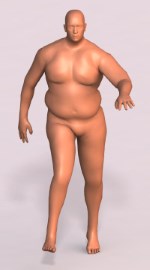Physically-Based Character Skinning

In this paper we present a novel multi-layer model for physically-based character skinning. In contrast to geometric approaches which are commonly used in the field of character skinning, physically-based methods can simulate secondary motion effects. Furthermore, these methods can handle collisions and preserve the volume of the model without the need of an additional post-process. Physically-based approaches are computationally more expensive than geometric methods but they provide more realistic results. Recent works in this area use finite element simulations to model the elastic behavior of skin. These methods require the generation of a volumetric mesh for the skin shape in a pre-processing step. It is not easy for an artist to model the different elastic behaviors of muscles, fat and skin using a volumetric mesh since there is no clear assignment between volume elements and tissue types. For our novel multi-layer model the mesh generation is very simple and can be performed automatically. Furthermore, the model contains a layer for each kind of tissue. Therefore, the artist can easily control the elastic behavior by adjusting the stiffness parameters for muscles, fat and skin. We use shape matching with oriented particles and a fast summation technique to simulate the elastic behavior of our skin model and a position-based constraint enforcement to handle collisions, volume conservation and the coupling of the skeleton with the deformable model. Position-based methods have the advantage that they are fast, unconditionally stable, controllable and provide visually plausible results.
@inproceedings{Deul2013,
author = {Crispin Deul and Jan Bender},
title = {Physically-Based Character Skinning},
booktitle = {Virtual Reality Interactions and Physical Simulations (VRIPhys)},
year = {2013},
month = nov,
address = {Lille, France},
publisher = {Eurographics Association}
}

